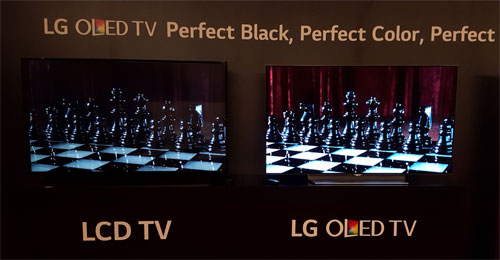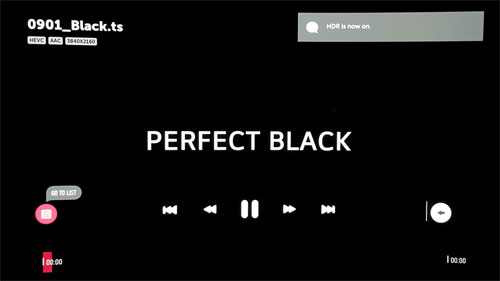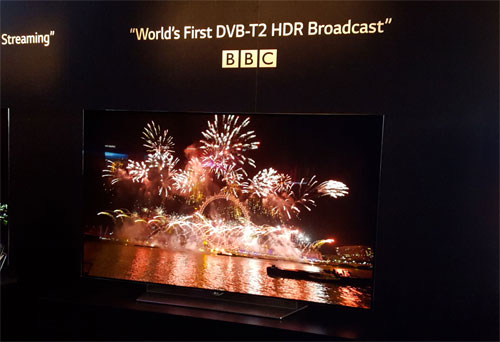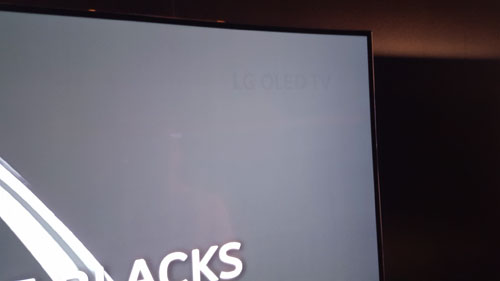OLED TV stalwart LG Electronics has taken the opportunity at last week’s IFA 2015 trade show to hit back at sceptics, by not only arguing the merits of OLED for HDR (high dynamic range) applications, but also exhibiting no less than four separate HDR source material on its OLED TVs. That video enthusiasts around the world are rejoicing at the launch of the South Korean manufacturer’s EF9500/ EF950V series of flat-screen (rather than yet another curved) OLED model almost seemed incidental.

Central to LG’s line of reasoning is, of course, OLED’s unmatched black-level reproduction. To drive home this advantage, the company actually placed all its OLED televisions showing broadcast HDR content in a pitch-black environment which was so dark that these awesome displays (including the new 65-inch 65EF9500/ 65EF950V flat OLEDs) could easily have been missed by IFA attendees.
Whilst the breathtaking black-level expression of OLED was never in doubt, it’s the peak brightness capability of this next-gen display technology that has come under fire from other TV makers who don’t currently offer a large-sized OLED solution. And LG has embarked on a persuasive defence on this point during an invite-only media briefing, by preferring to talk in terms of dynamic range instead of absolute peak luminance levels.
According to the company, its current iteration of OLED televisions (we took that to mean the 55EF950V and 65EF950V, and maybe some EG960V) can achieve a greater dynamic range than LED LCDs due to OLED’s near-zero black level, even if peak brightness is capped in the region of 400 nits. Using the aperture range on cameras as an analogy (which is ingenious), LG OLEDs can deliver around 20 f-stops, whereas LCD-based TVs are limited to 12 f-stops, although both technologies still have to employ some sort of adaptive tone mapping to preserve the content creators’ artistic intent.
Furthermore, LG correctly pointed out that LCDs cannot reach high luminance levels of 700 to 1000 nits without also washing out the blacks, thus negating any sizeable gain in intraframe contrast. The highest number of local dimming zones on an HDR-capable LED LCD TV is 240 at this time of publication; compare this against a 4K OLED TV’s 8,294,400 pixels (3840×2160) which can be switched on and off independently from each other thanks to the self-emissive nature of the technology, and you can see why videophiles treat OLED as the holy grail.

The Korean TV brand put together a side-by-side comparison of its 65EF9500 OLED TV against an LCD TV to highlight the virtues of the former, although we felt there’s room for improvement with the set-up. For one, the LCD was set far too dim, and the fact that it’s an IPS panel that’s already handicapped by subpar blacks didn’t really help either. Dr Nandhu Nandhakumar, senior vice president at LG Technology Centre of America, told us later that both displays were calibrated to 150 cd/m2, but when the HDR clip started playing the EF9500 would automatically kick into [HDR] mode outputting more light, accounting for the discrepancy.

Back on its darkened IFA show floor, LG showcased four 65EF950Vs displaying HDR broadcast content from EBU, BBC, Astra and a Broadcom set-top box respectively. As expected, blacks looked wonderfully inky, even as the intense fireworks sparkled in the night sky. The explosions and bright peaks were certainly more comfortable to watch in the dark on the OLED TVs, but if you’re expecting the same sort of “wow, that’s brilliantly bright” impact on HDR-ready LED LCDs, you may be left slightly disappointed.

We were slightly concerned at the sight of screenburn on one of the sets – hopefully this won’t be a problem in the home environment where there’s no content with static logo playing endlessly on loop.
 |
| Burned-in “LG OLED TV” caption on a 4K OLED TV |
We also spotted visible posterization in smooth gradients on the LG EF950V showing “A Million Ways To Die in The West” in HDR from a Broadcom set-top box, but the artefact could very well have come from the source rather than the display. We didn’t witness any significant near-black uniformity issues (vignetting, vertical banding) during our brief time spent with the flat OLED screens watching a limited amount of demo material, but of course would like to get our hands on a unit in our test room with our own test patterns before passing final judgement.
The LG 55EF950V and 65EF950V flat-panel ultra high-definition (UHD) OLED televisions are scheduled to be released in select markets in October. UK availability and prices remain unconfirmed, though we’d expect some sort of price parity with the existing 55EG960V and 65EG960V curved versions. We’ll bring you more details as they arrive.